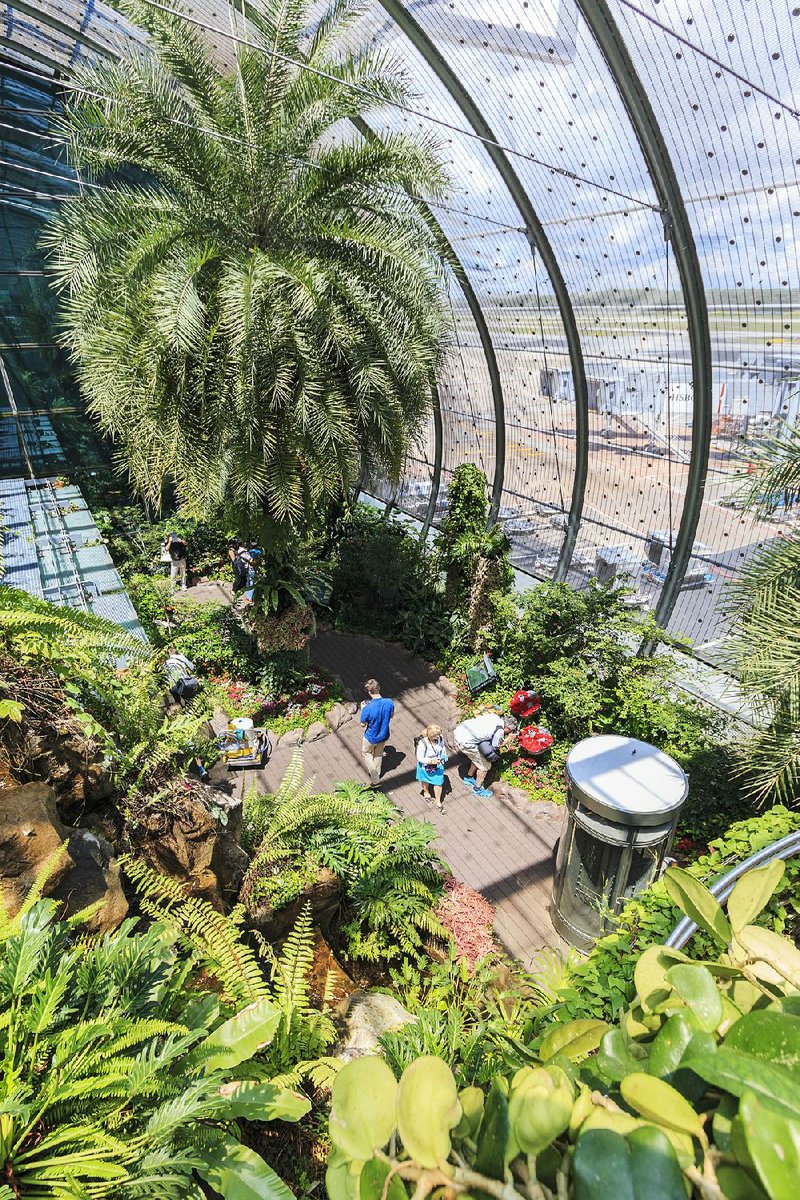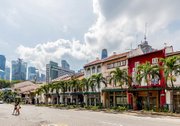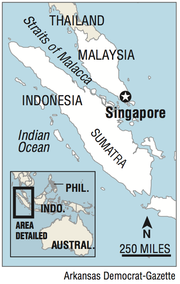When I recently told a friend I had gone to Singapore, she said, “hmm … hard for me to get excited about Singapore. Hope it was a gateway.”
Well, no, it was not. It was my destination.
If you go
Singapore is about 80 miles north of the equator, which means heat and humidity. Temperatures hover at 90 degrees during the day with little seasonal variation. It is slightly cooler in December and January and hottest in April and May. It rains year-round, but December and January are the rainiest.
INFORMATION
Singapore: yoursingapore.com
Gardens by the Bay: gardensbythebay.com.sg/ en/home.html
National Museum of Singapore: nationalmuseum.sg/ NMSPortal
The Intan: the-intan.com
Clarke Quay: clarkequay. com.sg/en
Raffles Hotel: raffles.com/singapo…
Changi WWII War Trail tour: journeys.com.sg/ singaporewalks/tours_ changiww.asp
And I loved it.
Understand, this is no Third World country. It kind of reminds me of South Korea, the way everything has been updated and, yes, sanitized.
There is the well-known Way of Singapore Life — no spitting, no chewing gum, no, well, a lot of stuff. Rainwater belongs to the state. Locals can’t collect their own.
The government heavily recommends (that means virtually orders) locals to buy a new car every 10 years. That, a local friend explained in a way that made me understand he thoroughly agreed, is so beater cars don’t break down on the highways and thus hold up Singapore’s main purposes in life — business and efficiency.
One upside is no, or at least very little, crime.
I went out for breakfast one morning and somehow left my hotel room door ajar. I came back hours later (not my original intention) and not a thing had been touched — not my expensive laptop or my cellphone or any of the other goodies you leave lying around when you think you’ve just stepped out for a few minutes.
What did I like about Singapore?
First and foremost: Gardens by the Bay, which I will describe later.
The various ethnic neighborhoods.
The food.
The public transportation, which is saying a lot for someone (me) who loathes public transit.
The night life.
And more food.
First, a bit of information. Singapore is a group of islands that sits just off the southern tip of the Malay Peninsula, about 80 miles north of the Equator. The main island is 14 miles north to south, 26 miles east to west.
It’s a city state, meaning the entire tiny country is a single city which is divided into many districts.
It’s also less than 200 years old. Modern Singapore was founded in 1819 by Sir Thomas Stamford Raffles as a trading post of the East India Co.
For much of that time, Singapore had a somewhat sketchy reputation. It was Lee Kuan Yew who forged the Singapore of today with its emphasis on rapid economic growth, support for business entrepreneurship and, yes, limitations on democracy. Today, it is one of the world’s major commercial hubs, the fourth-largest financial center and one of the five busiest ports.
I found Singapore to be a great walking city. I’m not big on huge, gleaming megahotels and, rather, stayed in the New Majestic, a boutique hotel with 30 rooms (and swimming pool) just a couple of blocks from the light rail system. It was just blocks from the center of Chinatown, with its shopping stalls, impressive temples and lots of small eateries.
The other districts — Little India, Malay District (known as Kampong Glam), Tiong Bahru with its food courts and others — are also great for walking.
Ah, let’s get to the good stuff … rooftop views, must see spots … food! First, the views:
The place everyone heads to is the Marina Bay Sands Skypark Observation Deck. You can’t miss the hotel, one of Singapore’s most distinctive. It stands like a three legged tower with a massive boat sitting across its top. That boat is the rooftop deck, with swimming pool, bar, restaurants, palm trees. It costs $17 to go up and the views are spectacular. But …
For killer city views at a bargain $3.70, head to the 50th-floor rooftop of Pinnacle, the world’s largest public housing complex. Landscaped and dotted with artwork and beach chairs, its sky bridges connect seven towers and provide a gobsmacking, 360-degree sweep of city, port and sea.
1-Altitude, an intense millennial-focused bar, 63 stories up the OUB (United Overseas Bank) Building. It comes with strobe lights, booming music, cover model locals looking like they stepped out of Maserati ads, exotic drinks and the highest viewpoint of the city.
And my serious favorite, the rooftop bar and walking platform of IndoChine, the restaurant atop the tallest “Supertree” of Gardens by the Bay. It comes with views of the Sands, the Singapore Flyer Ferris wheel and so much more. Yes, it’s lower than 1-Altitude, but the rooftop has plenty of room for you to set up a tripod and photograph the skyline without glass, strange railings or a crush of bodies in your way.
Singapore truly comes to life at night.
No amount of outdoor air conditioning and giant sun shades could persuade folks to do Clarke Quay by day, thanks to sweaty equatorial heat. But at night, the transformed warehouse district becomes a magical fantasy land of moving lights, bustling shops and pubs attracting 2 million people a year.
Gardens by the Bay, spectacular enough by day, turns into magic at night. Just about any street shimmers with brilliantly colored lights.
Now on to the food.
It’s hard to eat poorly in Singapore. The days of locals squatting along sidewalks serving delicacies from steaming woks is long, long gone. Street food is all inside well regulated food courts. One of the best known is in Tiong Bahru Food Centre, but you can find a food court just about anywhere.
A short stroll from my hotel, I stumbled upon China Town Food Street, with, among many, many other things, noodle soups, prawn fritters, half a dozen varieties of duck, crispy fried carrot cake, oysters, assorted barbecue seafoods … Indian, Vietnamese, Korean, vegetarian and a scattering of places that advertise they are organic.
Then, there are the sitdown restaurants. Across from my hotel was Candlenut, a Peranakan (a blend of ethnic Chinese/Malay and more) pork was so tender, it almost had no substance and was intensely flavored.
One of the sweet little surprises of the trip was a coffee bar in the Changi Village district where I discovered an amazing mango bacon sandwich and 3-D art lattes where somehow they carve standing foam kitties, piggies and whatnot atop iced lattes. The regular, Western sandwiches (roast beef for one) were of impeccable quality with fresh lettuce, medium rare roast beef slices and thick homemade bread.
Sorry, you do not go to Singapore to lose weight.
We did come up for air occasionally to do something other than eat. The details are in the accompanying story.
Would I go back to Singapore? Yes, absolutely. Only this time I would spend an entire week instead of just a few days.
To view a photo diary of Singapore:
tinyurl.com/qgfd7sl
restaurant where dishes were served family style. We had Ngoh Hiang — deep fried bean curd rolls stuffed with minced pork, various coconut curries and (OK, I didn’t say this was my favorite) stinky durian ice cream.
At Clarke Quay, we dove into the iconic “chilli” crab at Jumbo. Honestly, the crab, with its hard shells covered in chili sauce, was more trouble than it was worth. But the rest of the fish dishes — prawns, seafood rice, braised abalone in oyster sauce, some kind of whole fish — were fantastic.
For casual places, there was Char, which focuses on Chinese-style meats and includes a surprisingly tasty beef lung dish and more kinds of pork than I could count.
For fancy, there was Indo-Chine. My absolutely favorite food, perhaps of the whole trip, was a Vietnamese dish called Thit Heo Kho, braised pork belly with quail eggs in coconut cream set in a coconut husk and served with fresh coconut slices. The



